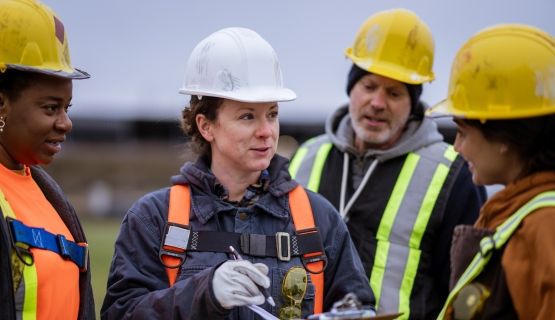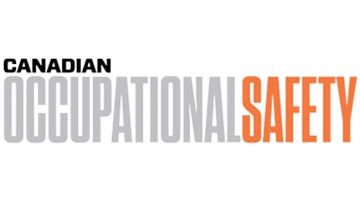Illness/injury prevention
IWH has a long history of conducting research to provide practical guidance to employers, workers, OHS professionals and regulators about what works and what doesn’t in injury or illness prevention. This research targets the injury and illness prevention practices of workplaces, as well as the programs developed by governments, health and safety associations and others to support and motivate workplaces to adopt effective practices.
Featured

At Work article
Differences in firm-level AI use for health and safety
To what extent are Canadian workplaces using artificial intelligence (AI) to help support workers’ health and safety? And what do these workplaces have in common? An IWH study surveyed firms across Ontario and British Columbia to find out.
Published: October 8, 2025

Impact case study
Saskatchewan’s construction safety group uses IWH tool to improve safety culture
This case study details how the Saskatchewan Construction Safety Association (SCSA) members have been analyzing IWH-OPM scores to adjust their safety practices and how SCSA has been using the data to tailor their outreach.
Published: February 10, 2025

At Work article
Employers struggle to provide newcomers with OHS training, support: IWH study
Employers are responsible for providing OHS training and support to keep workers safe. When it comes to workers who are new to Canada, workplaces face particular challenges following through on this responsibility.
Published: November 2022

Impact case study
Saskatchewan’s construction safety group uses IWH’s safety culture tool to measure OHS among member employers
When the Saskatchewan Construction Safety Association went looking for a tool to measure the OHS performance of its members firms, it turned to the Institute's easy-to-use, eight-item safety culture measure—the IWH-OPM.
Published: November 2022
Journal article
Journal article
Employers' experiences with safe work integration of recent immigrants and refugees
Published: Safety Science, July 2022
Project
Project
Artificial intelligence and occupational injury and illness in Ontario: implications for prevention and recovery
This study—one of the first of its kind to better understand the implications of AI for Ontario’s health and safety system—will build the evidence base on the scope and use of AI applications in OHS and RTW.
Status: Ongoing

Impact case study
IWH recommendations contribute to enhancement of the WSIB’s Health and Safety Index
When the WSIB decided to revisit the methods behind the Health and Safety Index, two IWH researchers provided advice on areas where the index could be improved. In October 2021, the HSI was revised, incorporating many of the suggestions provided by IWH.
Published: May 2022

Issue Briefing
Estimating the financial return on employers’ investments in the prevention of work injuries in Ontario
Following a 2017 study to estimate occupational health and safety (OHS) expenditures by employers with 20 or more employees in Ontario, Canada, an Institute for Work & Health (IWH) team has set out to estimate the financial return on those OHS expenditures. This Issue Briefing shares findings from that follow-up study.
Published: May 2022

At Work article
Over a third of work-related ER visits in Ontario don’t show up as WSIB claims
About 35 to 40 per cent of emergency department visits in Ontario for the treatment of work-related injuries and illnesses don't show up as workers' compensation claims—indicating a level of under-reporting that's consistent with previous estimates.
Published: March 2022

Impact case study
WSIB includes Institute safety culture tool in Health and Safety Excellence Program
Ontario's Workplace Safety and Insurance Board made a modified version of an Institute safety culture tool called the IWH-OPM available to firms as a voluntary component of participating in its Health and Safety Excellence Program.
Published: March 2022

Research Highlights
Implementing participatory ergonomics in the long-term care sector
It can be challenging to tackle long-standing musculoskeletal hazards in busy, high turnover settings such as long-term care homes. Despite this, an IWH study finds a participatory approach—one that involves frontline workers—can be successfully implemented and sustained.
Published: February 2022

IWH in the media
Ontario ministry could recommend changes to working-at-heights training
A testimony from William Roy, a senior Ministry of Labour, Training and Skills Development (MOL) policy manager, revealed potential changes to working at heights (WAH) training which could be implemented as soon as April.
The revelation came on day three on Ontario’s swing stage inquest into the 2009 scaffolding collapse at an Etobicoke high rise, in which four people died. Roy's testimony included suggestions for training reforms, contained in a Feb. 2019 report conducted by the Institute for Work & Health (IWH) and commissioned by the Ministry.
The revelation came on day three on Ontario’s swing stage inquest into the 2009 scaffolding collapse at an Etobicoke high rise, in which four people died. Roy's testimony included suggestions for training reforms, contained in a Feb. 2019 report conducted by the Institute for Work & Health (IWH) and commissioned by the Ministry.
Published: Canadian Occupational Safety , February 2022